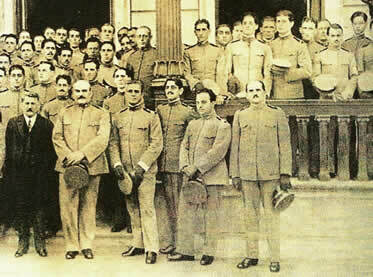Throughout the 1760s and 1770s, political relations between England and the Thirteen Colonies became increasingly complicated. On the one hand, England wanted to impose taxes and demands that it had never before imposed on American colonists. On the other hand, the inhabitants of the Thirteen Colonies, accustomed to autonomy, did not intend to submit to this new policy of the British metropolis.
Dissatisfied with this situation, the most prominent representatives of the colonies decided to meet at the First Continental Congress of Philadelphia, organized in 1774. At this event, its participants drew up a document in which they demanded the end of taxes established by the British authorities. Without relying on separatist pretensions, this first political action by the settlers was intended to peacefully reverse the interventionist tone adopted by the British.
Without achieving the expected effect, other settlers believed that the military conflict could put an end to the colonialist pretensions of the English government. In 1775, some colonists already organized militarily to carry out a confrontation against England. That same year, during the Second Continental Congress in Philadelphia, a larger contingent of supporters advocated definitive separation through the organization of direct confrontation.
Mind Map: American Revolution

*To download the mind map in PDF, Click here!
In June 1776, Virginia declared its independence after publishing the Declaration of Human Rights. The following month, inspired by the action of the first colony, the other US supporters enacted the Declaration of Independence, drafted by the action of leaders Samuel Adams, Benjamin Franklin and Thomas Jefferson. Before that, US troops took the city of Boston, an action that marked the first clashes against British forces.
Do not stop now... There's more after the advertising ;)
Initially, without a cohesive military organization, the colonists suffered defeats by the already experienced and well-equipped English troops. In many cases, settlers were torn between maintaining their crops and participating in the battlefields. Even though they were successful at the Battle of Saratoga (1777), the American leaders well knew that they could not win this confrontation without the forthcoming support of some European power.
So Benjamin Franklin was sent to negotiate the military support of France, which wanted a rematch after England's defeat in the Seven Years' War (1756 - 1763). Through the action of the Marquis de La Fayette, the French government sent a detachment of 7,500 men to be led by General Rochambeau. Shortly thereafter, the French themselves convinced Spain to also fight the British.
Thanks to the military support they received, the colonists were finally able to defeat the British metropolitan forces at the Battle of Yorktown in 1781. Two years later, the political authorities of England recognized the independence of the Thirteen Colonies with the signing of the Treaty of Paris. In France, knowledge of the liberal ideological tone taken in the wars of independence inspired the development of the French Revolution in 1789.
By Rainer Sousa
Graduated in History
*Mental Map by Daniel Neves
Graduated in History
Would you like to reference this text in a school or academic work? Look:
SOUSA, Rainer Gonçalves. "US War of Independence"; Brazil School. Available in: https://brasilescola.uol.com.br/guerras/guerra-independencia-dos-estados-unidos.htm. Accessed on June 28, 2021.

